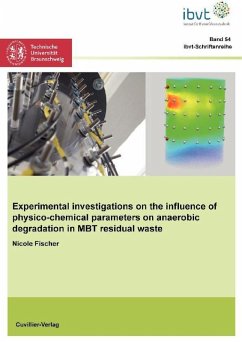In this work, MBT residual waste was used for experimental studies to investigate the influence of crucial
parameters influencing biochemical processes in anaerobic degradation in residual wastes from MBT. The
moisture content is one of the most critical parameters influencing biogas production in waste as well as
nutrient transport. Batch experiments were carried out to correlate moisture content and biogas production in
MBT residual waste. Moreover, quantification and monitoring of heterogeneous moisture distribution in a
landfill body is critical for mechanical landfill stability and landfill gas emission control. For quantitatively
monitoring in-situ moisture distribution in in MBT residual waste, a novel geoelectrical technique was
successfully applied and evaluated on laboratory scale. The pH development in leachate from MBT residual
wastes and the relating acid buffering intensity was found to be important for facilitating biochemical
conversion of solid organic carbon matter to biogas. At unadjusted conditions, a positive correlation between
strength of acidification phase and biogas production, especially methane production, could be found.
Thereby, the acid buffer intensity of MBT residual wastes proved to be crucial for pH stabilisation. Due to
maximum cumulative biogas production at neutral pH, pH regulation at pH 7 is recommended for waste
treatment in MBT plants and landfill bioreactors. The bioavailability of metabolic intermediates was
investigated with regard to their sorption behaviour on MBT residual wastes. Alcohols of a homologous
series with increasing octanol-water partition coefficients POW were used as surrogates for carboxylic acids.
Activated carbon was used as a reference sorption system due to its high specific surface area. By
determining the distribution coefficient KD, the bioavailability factor Bf was quantified and denotes that
bioavailability of the surrogates was practically unlimited. Transferring these results to intermediates of the
anaerobic degradation with similar log POW values, e.g. acetic acid and propionic acid, reveals that
biodegradation of certain organic substrates e.g. acetic acid or propionic acid can be considered unconfined
in MBT residual waste.
Dieser Download kann aus rechtlichen Gründen nur mit Rechnungsadresse in A, B, BG, CY, CZ, D, DK, EW, E, FIN, F, GR, HR, H, IRL, I, LT, L, LR, M, NL, PL, P, R, S, SLO, SK ausgeliefert werden.


